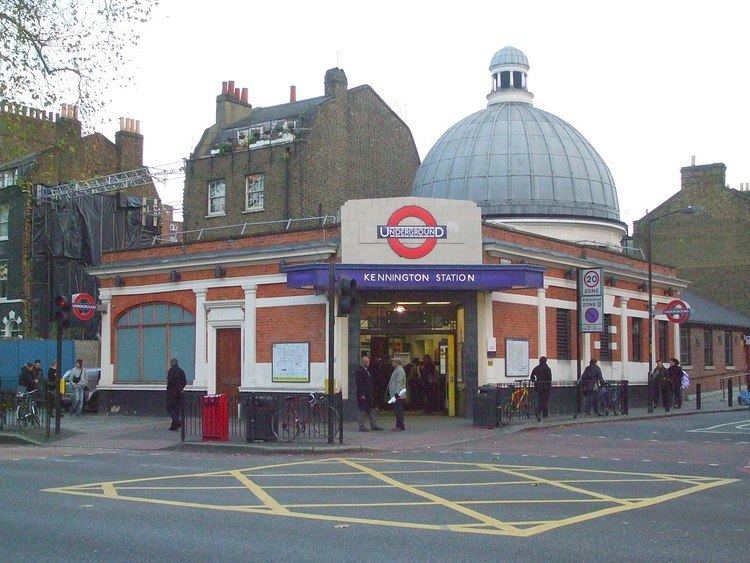Fare zone 2 2013 4.68 million | Managed by London Underground 2012 4.59 million 2014 4.96 million Number of platforms 4 | |
 | ||
Address London SE11 4JQ, United Kingdom Similar | ||
Kennington tube station london 16th july 2011 15 38
Kennington is a London Underground station on Kennington Park Road in Kennington on both the Charing Cross and Bank branches of the Northern line. It is within the London Borough of Southwark. Its neighbouring stations to the north are Waterloo on the Charing Cross branch and Elephant & Castle on the Bank branch; the next station to the south is Oval. The station is in Travelcard Zone 2.
Contents
- Kennington tube station london 16th july 2011 15 38
- History
- Today
- Features
- Services and connections
- Kennington loop
- References
History
The station was opened on 18 December 1890 as part of London's first deep-level tube, the City & South London Railway (C&SLR) (now the Bank branch of the Northern line). The name 'Kennington' was adopted instead of 'Kennington Park Road' although in fact it was in the civil parish of Newington and thence became part of Southwark rather than in the Kennington part of Lambeth. The layout was originally similar to the current arrangement at Borough, with one platform (the northbound) having level access to the lift, and the other (the southbound) being one floor below it.
Two extra platforms were added in 1926, when the connection via Waterloo to Embankment on the former Charing Cross, Euston & Hampstead Railway (now the Charing Cross branch) was built. At that time the old northbound platform was reconstructed, so that the track runs down the other side of the tunnel (to allow cross-platform interchange), resulting in unusually large tunnel mouths; this also produced an apparently mysterious door in the wall opposite the platform - the original access to the platform is concealed behind the door.
Since the original access to the northbound platform had been level with the lifts, it would now have been necessary for passengers to ascend stairs, cross a bridge over the tracks, and then descend again. Therefore, to ease the burden on passengers, the lift landing was raised up, by one floor, to the bridge level; this is why there are now so many stairs to the southbound platform. The old entrances to this platform, which had a more decorative appearance than the current entrances, still survive; despite this, the existence of these abandoned areas is not generally known to the public.
Unlike the other original C&SLR stations at Stockwell, Oval and Elephant & Castle, which were all rebuilt during the 1920s modernisation, and despite the major works taking place underground, Kennington's surface building saw little in terms of a physical update at that time. It is therefore the only station of the C&SLR's original section still in a condition close to its original design.
In order to improve the ventilation facilities of the station, without harming the historic fabric of the surface station, additional staff access from the surface to the tunnels has recently been built a short distance to the north, on the opposite side of the main road (adjacent to the pub). The station reopened after its first extensive refurbishment in more than eighty years.
Despite having a heavy footfall from all the transferring passengers from the Southbound Charing Cross branch service, the Southbound Bank branch platform has no advertising panels opposite the platform.
Today
The station has two passenger lifts but no escalators. The platforms can also be reached via the 79-step staircase.
Refurbishment work at Kennington was completed in 2005.
Features
The 20 A1-sized panels inside the two lifts, normally used for posters, were occupied in 2010 by the work of the 16 MA students at the City & Guilds of London Art School. This public art display was held to coincide with the City and Guilds MA Fine Art Show (9–12 September 2010), when the students showed their work in the Georgian surroundings of the school’s historic site on the edge of Cleaver Square just a two-minute walk from here.
Since 2005 Art Below have set about changing the everyday travelling experience, transforming entire platforms and corridors using advertising space to display the works of emerging artistic talent. This was the first time that they had transformed a lift into an art gallery!
Services and connections
Train frequencies vary throughout the day but generally operate every 3–6 minutes between 06:01 and 00:19 northbound to Edgware or High Barnet via the Charing Cross or Bank Branch and every 2–5 minutes between 06:01 and 00:41 southbound. During peak times, northbound trains are also scheduled to terminate at Mill Hill East. An average time taken for a Northern line train to travel between Waterloo and Kennington is approximately 3 minutes and 50 seconds.
London Bus routes 133, 155, 333 and 415 and night routes N133 and N155 serve the station.
Kennington loop
A loop tunnel south of the station enables southbound Charing Cross branch trains to be terminated at Kennington, leave the station in a southward direction and, traversing the loop, enter the northbound Charing Cross branch platform. Because of the arrangement of junctions, trains using the loop cannot reach the northbound Bank branch platform nor can trains from the southbound Bank branch reach the loop. For southbound Charing Cross branch or Bank branch trains to reach the northbound Bank branch platform a reversing siding between the two running tunnels must be used.
Because of the layout, it is almost always southbound Charing Cross branch trains that terminate at Kennington. One of the station's four platforms is thus mainly used by terminating trains and sees relatively few operational southbound departures.
